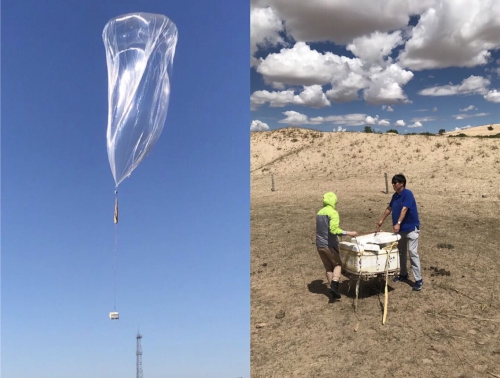
Most researches on stratosphere and troposphere exchange (STE) are carried out using model simulations. A new study conducted by Chinese researchers directly revealed the phenomenon through in-situ measured high-precision profiles. The study was published in Advances in Atmospheric Sciences.
"Such height coverage and high-precision in-situ measurement profiles of trace gases are very rare in China," said Prof. LIU Yi from the Institute of Atmospheric Physics (IAP) of the Chinese Academy of Sciences, a co-author of the study. "Also, the profiles are valuable in many areas, such as the retrieval of local surface flux, model validation, and atmospheric transport research."
The method used for measuring these profiles, called aircore, was applied for the first time in China. Specifically, the balloon-borne aircore campaign was conducted at Xilinhot, Inner Mongolia, China, on June 11 and 15, 2018. During the campaign, two experiments were conducted, on June 13 and 14, respectively, in which CO and CO2 profiles from the surface to around 25 km were measured.
The structure of the profiles on these two days were totally different from the boundary layer to the middle stratosphere, and the inter-relationship between the two trace gases changed from positive to negative. The positive relationship between CO and CO2 was intelligible, but the negative one was rarely seen.
Based on meteorological analyses and XCO2 (the total column mixing ratio of CO2), the negative relationship was caused by the link between the low CO concentration and high CO2 concentration, and vice versa.
From the vertical perspective, the laminar structure in which the high CO concentration and low CO concentration were intertwined was caused by the process of STE. From the horizontal perspective, the CO2 gradient was large. The 3-D atmospheric structure was well considered.

Successful launch (left) and return (right) of aircore in Inner Mongolia on June 13, 2018 (Image by YI You and FANG Shuangxi)
According to Prof. LIU, the first aircore campaign was successful because the STE process was well observed and illustrated, which is rare. They also conducted two other aircore campaigns in Inner Mongolia in November 2018 and on the Tibetan Plateau in August 2019, respectively.
"There are more trace gases from the Tibetan Plateau campaign to be measured, such as CO2, CO, CH4, N2O and O3. We want to investigate the pathways through which pollutants released from the surface are transported to the lower stratosphere under the control of the South Asian high, and this research is underway," said Prof. LIU.

86-10-68597521 (day)
86-10-68597289 (night)

52 Sanlihe Rd., Xicheng District,
Beijing, China (100864)

